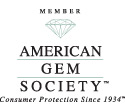Already know what you're looking for? Search for a stone with
Mardon’s diamond brokerage service!
The 4 Cs of Diamond Quality
Clarity
Viewing inside a gemstone is like opening a portal to another world. Looking into that portal can tell us important facts about how that gem was formed, and the trip it took from the molten core of the Earth up through the crust and into our hands. Looking at the internal world of a diamond can tell us if it is natural or synthetic, and even how it will stand up to daily wear in an engagement ring. Most importantly, inclusions can be like a fingerprint, and can help you identify your diamond.
A diamond’s clarity is a measurement of its internal and external characteristics. Inclusions are under the surface, inside the diamond. Blemishes are marks only on the diamond’s exterior. Most diamonds have some clarity characteristics, including crystals and breaks in the surface known as feathers.
Diamonds are graded for clarity using a ten power binocular microscope with special lighting used to illuminate the inclusions. The diamond is given a specific grade, from flawless and internally flawless (F and IF) to included (I).
A trained gemologist uses a microscope to grade clarity because diamonds that are slightly included (SI) or better are clean of inclusions to the naked eye. Diamonds graded Included (I1, I2, and I3) have inclusions that interfere with the beauty and durability of the stone. Mardon recommends diamonds in the Slightly Included (SI) or Very Slightly Included (VS) grades because we think they offer the best combination of beauty and value. Diamonds with very few or no clarity characteristics (VVS to Flawless stones) are rare and costly. These stones are alluring because of their rarity, but are truly more beautiful only under a microscope.
Cut
Diamonds are unique in many ways. They are uniquely hard, uniquely good at transferring heat, and the only gem made up of only one element, carbon. In jewelry, diamond’s most important unique property is the special way they interact with light.
In a well-cut diamond, when light enters the top, all that light is returned out the top in a brilliant mixture of white light and rainbow scintillation. In a poor cut, some of that light leaks out the sides or the back, leaving the stone lifeless and dark.
You’re probably wondering: if diamond cutters know how to cut a diamond perfectly and make it as beautiful as possible, why don’t they do that every time? The reason is that the rough diamond is so valuable, the cutter must make a decision between beauty and saving as much of the rough diamond as he can. Some rough stones are only suited to fancy shapes, like the shallow baguette cut. Even if the rough is well formed, a diamond cutter may be able to make more money on a larger poorly cut stone than a smaller ideal cut stone. The ideal cut must also be perfectly proportioned to return all light, and requires the highest level of precision and skill from the most expert diamond cutters. That is why the ideal cut commands a higher price in the marketplace.
In 1919 Marcel Tolkowsky released his plans for cutting the ideal diamond, and it is his model that the American Gem Society looks to today when judging diamond cuts. The Gemological Institute of America recognizes the precise Tolkowsky brilliant cut as one of many perfectly cut diamond styles, measured by sophisticated light return technology. Many “branded” diamond cuts have come on the market recently, all claiming to have perfected the most beautiful diamond. Our expert staff at Mardon–including our owner Jim Sweaney, former supervisor at the GIA diamond grading lab–have examined many of these “perfect stones”. Many have ideal proportions and are very beautiful, but each one of these “branded” diamonds also has a marketing gimmick. This may be a special scope that shows you its perfect symmetry or extra facets for added brilliance. In our experience, none of these stones is more “ideal” than any other precisely cut stone, just more expensive.
We recommend that our customers treat themselves to the very best cut they can afford. An ideal cut diamond is absolutely spectacular.
Color
Diamonds can be found in many body colors, from the colorless diamonds we are most familiar with to cool blues, feminine pinks, and warm, sunny yellows. Most diamonds are tinted slightly, usually light yellow or brown. More intense yellow and brown shades and all other hues are called “fancy” colors. A diamond of any color can be beautiful–especially if it is well cut–but different colored diamonds are not all valued the same. The most rare and most valuable diamonds are found with either the least or the most color. So, diamonds without any color at all or with intense, deep colors–like bright yellow–demand the highest prices. Very subtle differences in color can make great differences in value.
At Mardon we use the GIA system for grading diamonds. This system grades non-fancy diamonds from D to Z.
When a trained gemologist grades color they use specially controlled conditions of lighting and background and a set of certified diamond master stones to ensure the most accurate and consistent grade. A person’s color vision is greatly affected by how they are feeling, so at Mardon we try and grade color early in the day before we get tired.
A diamond in the colorless range–D, E, and F–will have a crisp, icy look and provide a perfect foil for the rainbow colors an excellent cut can coax from your stone. In the near colorless range–G, H, and I–diamonds will show no color face up, but have slight tint when viewed from the side or bottom. Some people prefer the colors further down the scale in the very light yellow range–J and K–for their warmer color. We advise Mardon customers to buy the best color diamond that they can afford because color is one of the most noticeable characteristics of your diamond to the naked eye.
Carat
Carat is the measurement of how much a diamond weighs. One metric carat is equal to 1/5 of a gram. Diamonds are not sold by millimeter size, but by how much they weigh. That is part of why the cut of your diamond is so important. You wouldn’t want to pay for a 2 carat stone that only looked face up like a 1.5 carat stone.
Because finding one large rough diamond is harder than finding many smaller rough diamonds, as a diamond gets bigger it gets more expensive per carat. So, a one carat diamond can cost twice as much as two half carat stones, even though they are both one carat total weight. Diamonds also have price increases at important numbers, so a full one carat diamond will cost much more than a .99 carat stone, all other things being equal. For your best value, ask us at Mardon about buying a stone a little lower than any of the “Magic Diamond Numbers.
The Bonus C - Certification
Many diamonds today are sold with "Grading Reports," which are certificates from a professional diamond grading laboratory. These provide detailed information about the stone's weight, clarity and color grades, and provide a plot that maps the inclusions in the stone. Unfortunately, not all diamond certificates are created equal - some gemological labs have more lax standards and practices. We recommend diamonds certified by either GIA or AGS to our customers, as these labs are considered to be among the best in the business.







